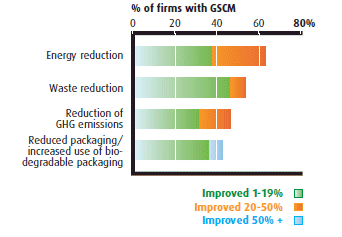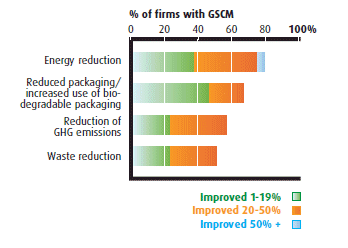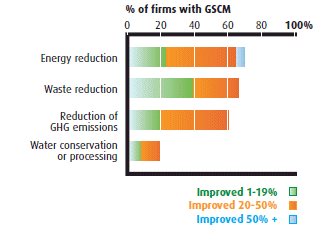Environmental Benefits of GSCM Practices
GSCM practices result in multiple environmental benefits for Canadian retail chains, CPG manufacturers, and CPG logistics and transportation service providers. For Canadian retail chains, these benefits include improvements in energy and waste reduction, decreased GHG emissions, and less packaging in distribution activities (Figure 5).
Retail chains have the opportunity to decrease GHG emissions and waste by retrofitting their distributioncentres (DCs) to be more environmentally friendly, such as investing in LEED–certified green buildings.Footnote V This process involves sorting building materials and maximizing recycling processes, which enables retail chains to access carbon credits. Carbon credits are granted according to the amount of GHG a business emits in its operations; unused credits can be sold to other companiesworldwide.
Figure 5: Environmental improvements stemming from GSCM practices in distribution activities — Retail chains 1

In responding to retail chain GSCM mandates, CPG manufacturers gain numerous environmental advantages. The most common improvements include energy reduction, decreased packaging and lowered GHG emissions in distribution activities (Figure 6).
Figure 6: Environmental improvements stemming from GSCM practices in distribution activities — CPG manufacturers1

In addition, CPG logistics and transportation service providers generate similar environmental benefitscompared with Canadian retail chains — such as energy reduction, GHG emissions, and waste reduction in theirdistribution activities (Figure 7). However, CPG logistics and transportation service providers are the only firmsthat report some improvement in water conservation in distribution activities. This improvement stems fromCPG logistics and transportation service providers reducing their environmental impact through waterconservation or improved processing. During normal vehicle repair and maintenance activities, vehicle fluidsmay drip or spill or otherwise enter floor drains or sinks in service areas, potentially introducing various toxicchemicals into sources of drinking water. To mitigate this, companies put processes in place to recovervehicle chemicals and fluids for re–use.2
Figure 7: Environmental improvements stemming from GSCM practices in distribution activities — CPG logistics and transportation service providers 1

To achieve environmental benefits, some global logistics and transportation service providers are usingroute planning software and Internet matching systems in their logistics service processes, while others arebeginning to use transportation vehicles with hybrid technology, thus integrating environmental managementinto their bottom–line results.2
Footnotes
- Footnote 5
LEED provides benchmarks for the design, construction and operation of a property and covers site makeup, building materials, water and energy efficiency as well as indoor environmental quality. It also provides certification for people who demonstrate an understanding of green building practices.
